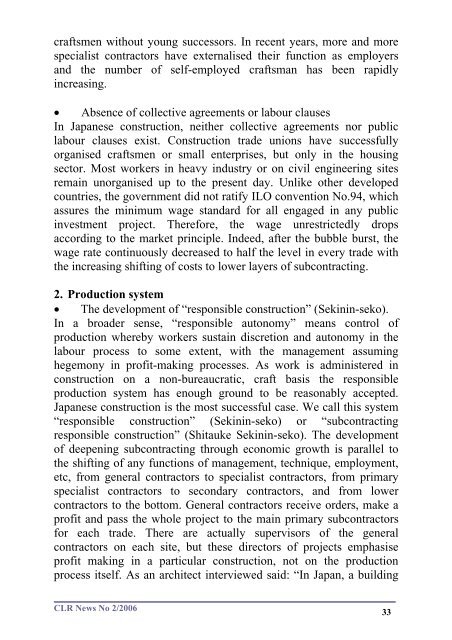Japan – what can we learn? - Construction Labour Research
Japan – what can we learn? - Construction Labour Research
Japan – what can we learn? - Construction Labour Research
You also want an ePaper? Increase the reach of your titles
YUMPU automatically turns print PDFs into web optimized ePapers that Google loves.
craftsmen without young successors. In recent years, more and morespecialist contractors have externalised their function as employersand the number of self-employed craftsman has been rapidlyincreasing.• Absence of collective agreements or labour clausesIn <strong>Japan</strong>ese construction, neither collective agreements nor publiclabour clauses exist. <strong>Construction</strong> trade unions have successfullyorganised craftsmen or small enterprises, but only in the housingsector. Most workers in heavy industry or on civil engineering sitesremain unorganised up to the present day. Unlike other developedcountries, the government did not ratify ILO convention No.94, whichassures the minimum wage standard for all engaged in any publicinvestment project. Therefore, the wage unrestrictedly dropsaccording to the market principle. Indeed, after the bubble burst, thewage rate continuously decreased to half the level in every trade withthe increasing shifting of costs to lo<strong>we</strong>r layers of subcontracting.2. Production system• The development of “responsible construction” (Sekinin-seko).In a broader sense, “responsible autonomy” means control ofproduction whereby workers sustain discretion and autonomy in thelabour process to some extent, with the management assuminghegemony in profit-making processes. As work is administered inconstruction on a non-bureaucratic, craft basis the responsibleproduction system has enough ground to be reasonably accepted.<strong>Japan</strong>ese construction is the most successful case. We call this system“responsible construction” (Sekinin-seko) or “subcontractingresponsible construction” (Shitauke Sekinin-seko). The developmentof deepening subcontracting through economic growth is parallel tothe shifting of any functions of management, technique, employment,etc, from general contractors to specialist contractors, from primaryspecialist contractors to secondary contractors, and from lo<strong>we</strong>rcontractors to the bottom. General contractors receive orders, make aprofit and pass the whole project to the main primary subcontractorsfor each trade. There are actually supervisors of the generalcontractors on each site, but these directors of projects emphasiseprofit making in a particular construction, not on the productionprocess itself. As an architect intervie<strong>we</strong>d said: “In <strong>Japan</strong>, a buildingCLR News No 2/200633









